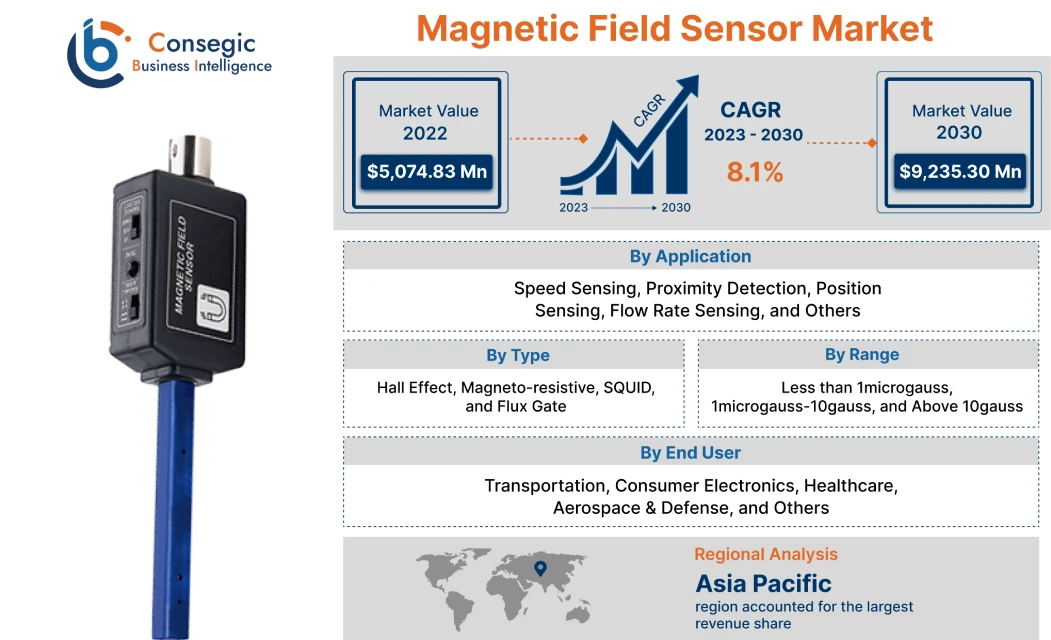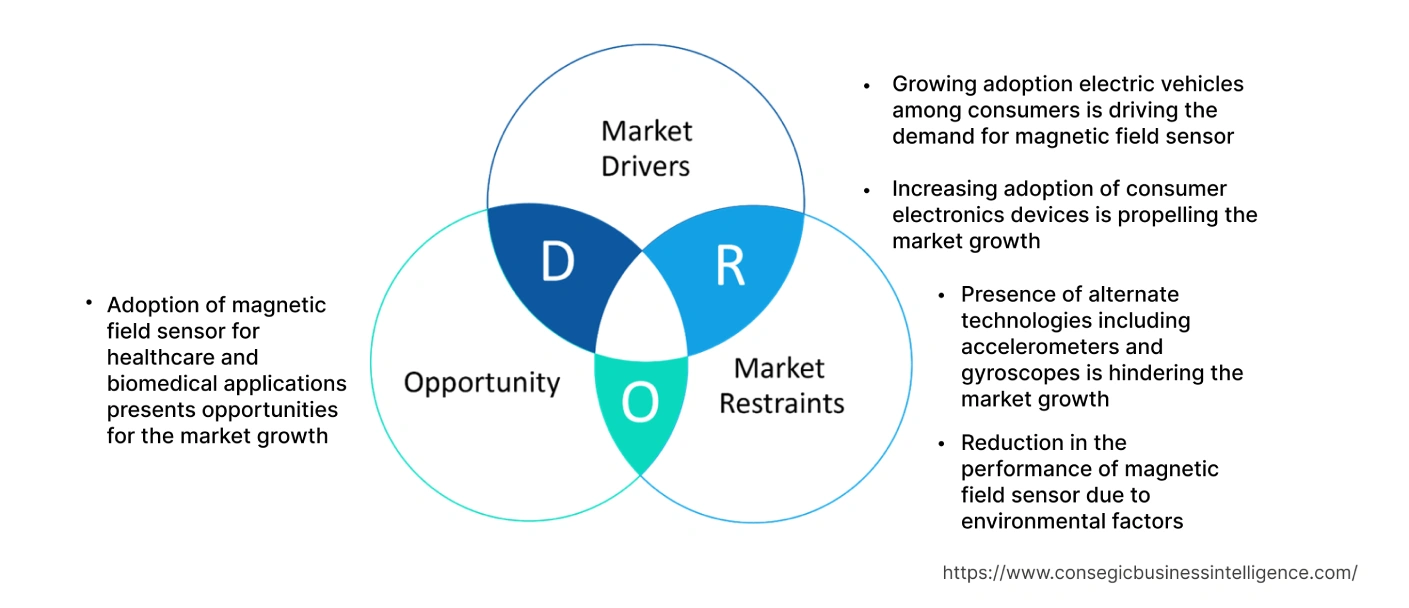- Summary
- Table Of Content
- Methodology
Magnetic Field Sensor Market Size :
Global Magnetic Field Sensor Market size is estimated to reach over USD 9,235.30 Million by 2030 from a value of USD 5,074.83 Million in 2022, growing at a CAGR of 8.1% from 2023 to 2030.
Magnetic Field Sensor Market Scope & Overview:
A magnetic field sensor is a device used for measuring the direction and strength of a magnetic field. It detects and measures the magnetic fields around current conductors, permanent magnets, and electrical devices. It detects the presence of a magnetic field and provides actionable data regarding the speed, rotation, positioning, and the direction of movement of an object. Its widely used in scientific measurement, navigation, and industrial applications.
Magnetic Field Sensor Market Insights :
Key Drivers :
Growing adoption electric vehicles among consumers is driving the demand for the sensor
The increasing adoption of Advanced Driver Assistance Systems (ADAS) in electric vehicles is driving the demand for magnetic field sensor in the automotive industry. It plays a crucial role in navigation, motor control, and position sensing in ADAS systems. As a result, ADAS technologies, such as collision avoidance systems, lane departure warning systems, and driver monitoring system rely on accurate and reliable data provided by the the sensor. For instance, in November 2022, Allegro MicroSystems, Inc. introduced new PCB-less 3D magnetic sensor called A31316 Hall-effect sensor well-suited for automotive safety and Advanced Driver Assistance Systems (ADAS) applications that require high performance and flexibility in harsh environments. Analysis of market trends concludes that the increasing application of the sensor in ADAS systems for navigation, motor control, and position sensing is driving the magnetic field sensor market demand.
Increasing adoption of consumer electronics devices
The increasing adoption of consumer electronics devices such as smartphones, tablets, wearable devices, and gaming consoles among consumers is driving the growth of the market. Magnetic field sensor is widely used in applications such as compasses, motion detection, and position detection, thereby enhancing the user experience and enabling new functionalities including gesture recognition, and augmented reality (AR) applications. It is crucial in tracking the position and movement of different components in smartphone cameras. For instance, in April 2023, TDK Corporation made an investment in the field sensor to increase the production capacity of TDK's TMR magnetic sensor that provide high precision, high reliability and enable stable operation in consumer electronics devices. Analysis of market trends concludes that the application of thesensor in consumer electronics devices due to its low power consumption is propelling the proliferation of the market.
Key Restraints :
Presence of alternate technologies including accelerometers and gyroscopes
The presence of alternate technologies including accelerometers and gyroscopes with orientation and motion sensing capabilities is hindering the proliferation of magnetic field sensor market. Accelerometers and gyroscopes provide similar functionalities by detecting the movement, speed and rotation of different objects without relying on magnetic fields. Analysis of market trends concludes that the availability of alternative sensor technologies is restraining the expansion of the market.
Reduction in the performance of sensor due to environmental factors
Magnetic field sensor has inherent limitations that affect its performance of in specific applications. It is susceptible to environmental factors such as temperature, electromagnetic interference, and nearby magnetic fields. Analysis of market trends concludes that reduction in its performance due to electromagnetic interference and nearby magnetic fields is restraining the proliferation of the market.
Future Opportunities :
Adoption of the sensor for healthcare and biomedical applications presents opportunities
The adoption of magnetic field sensor for healthcare and biomedical applications is expected to present growth opportunities for the market during the forecast period. It is used for accurate tracking of drug delivery systems and implantable devices. For instance, in February 2023, Massachusetts Institute of Technology revealed an ingestible sensor wherein the movement of the sensor is examined as it passes through the digestive tract by detecting the magnetic field produced by the electromagnetic coil located outside the body. Analysis of market trends concludes that the application of the sensor in magnetic resonance imaging (MRI) and other radiological testing technologies is expected to emerge as one of many magnetic field sensor market opportunities that will drive market expansion during the forecast period.
Magnetic Field Sensor Market Report Insights :
| Report Attributes | Report Details |
| Study Timeline | 2017-2030 |
| Market Size in 2030 | USD 9,235.30 Million |
| CAGR (2023-2030) | 8.1% |
| By Type | Hall Effect, Magneto-resistive, SQUID, and Flux Gate |
| By Range | Less than 1microgauss, 1microgauss-10gauss, and Above 10gauss |
| By Application | Speed Sensing, Proximity Detection, Position Sensing, Flow Rate Sensing, and Others |
| By End-User | Transportation, Consumer Electronics, Healthcare, Aerospace & Defense, and Others |
| By Region | North America, Europe, Asia-Pacific, Latin America, and Middle East & Africa |
| Key Players | Allegro Microsystems, Inc., Alps Electric Co., Ltd., AMS AG, Asahi Kasei Microdevices Corporation, Baumer Ltd., Crocus Technology, Elmos Semiconductor AG, Honeywell International, Inc., Infineon Technologies AG, Magnetic Sensors Corporation, Melexis Corporation, Memsic Corporation, NVE Corporation, NXP Semiconductors, TDK Corporation, Texas Instruments Incorporated, MultiDimension Technology Co. Ltd. |
Magnetic Field Sensor Market Segmental Analysis :
By Type :
Based on the type, the market is segregated into hall-effect, magneto-resistive, SQUID, and Flux Gate. The hall-effect segment accounted for the largest revenue share of 33.75% in the year 2022. Analysis of market trends concludes that the simplicity, low-cost, and versatility of sensor is driving the proliferation of the market. It utilizes the hall effect that generates a voltage perpendicular to both the current flow and the magnetic field in a conductor. For instance, in July 2020, Texas Instruments Incorporated launched zero-drift Hall-effect current sensor called TMCS1100 and TMCS1101 that enable low drift and high accuracy in industrial motor drives, energy-storage equipment and power supplies. Consequently, the ability of hall-effect sensor to provide high measurement accuracy is driving the expansion of the market.
The magneto-resistive sensor is expected to emerge as the fastest-growing segment during the forecast period. Magneto-resistive sensor include Anisotropic Magneto Resistive (AMR), Giant Magneto Resistive (GMR), and Tunnel Magneto Resistive (TMR) sensor that detect changes in electrical resistance of a material when exposed to a magnetic field. Magneto-resistive sensor is widely used in automotive systems, industrial control, and consumer electronics devices for motion control and sensing applications. Analysis of market trends concludes that the ability of magneto-resistive sensor to consume less power and offer higher level of sensitivity is expected to drive the market proliferation during the forecast period.
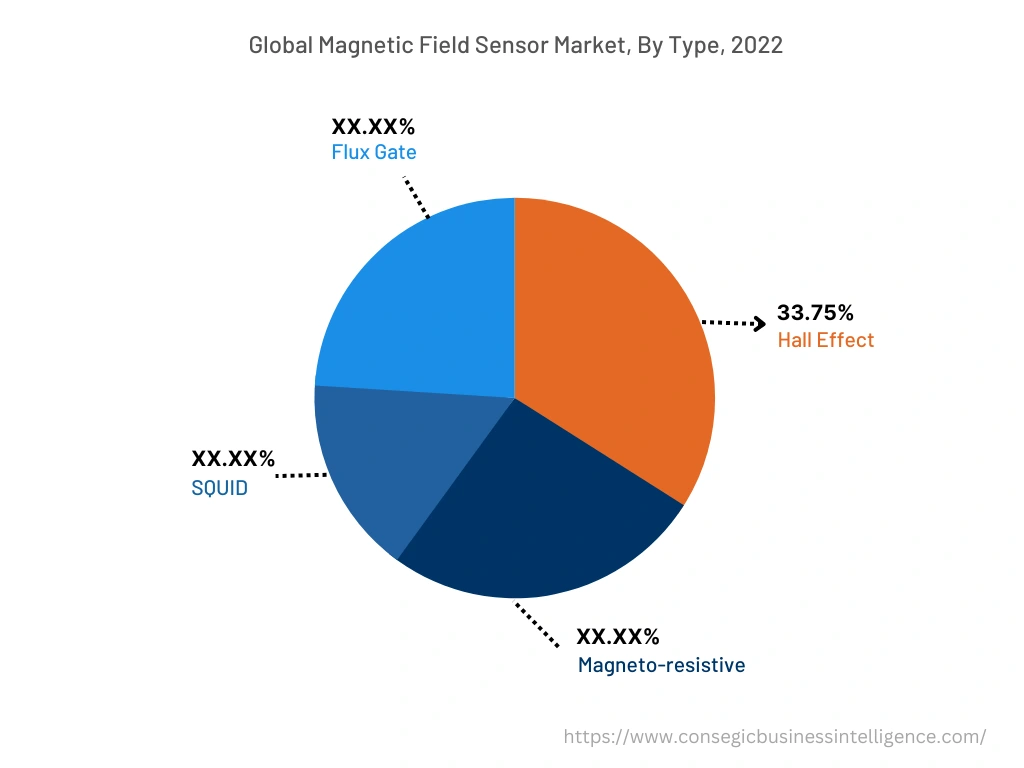
By Range :
Based on the range, the market is separated into less than 1 microgauss, 1 microgauss-10 gauss, and above 10gauss. In 2022, the 1microgauss-10gauss segment accounted for the highest magnetic field sensor market share. The application of the sensor in compasses, current sensor, position sensor, proximity sensor, and electronic compasses is driving the expansion of the market. The sensor has the ability to detect magnetic fields in the range of 1 microgauss to 10gauss.
The above 10 gauss segment is anticipated to register fastest CAGR during the forecast period. Sensors under this segment provides accurate measurements of strong magnetic fields and are essential in industries that require precise control and monitoring of high field strengths. For instance, in May 2023, MultiDimension Technology Co. Ltd. launched TMR265x linear magnetic field sensor featuring measurement range up to ±1000 Gauss in high-speed power electronics. Therefore, the application of the sensor in industrial automation, magnetic materials testing, and magnetic field mapping applications is driving the magnetic field sensor market growth.
By Application :
Based on the application, the market is segmented into speed sensing, proximity detection, position sensing, flow rate sensing, and others. Speed-sensing segment accounted for the largest revenue share in the year 2022. The sensor is utilized to measure the rotational speed of components such as wheels, motors, and shafts. Thus, it plays a crucial role in applications including automotive speedometers, anti-lock braking systems (ABS), and industrial speed monitoring systems. For instance, in April 2020, Shanghai MagnTek Microelectronics Inc. launched magnetic speed detection switch IC called MT890X featuring 3rd generation speed with direction latch switch for automotive applications.
The proximity detection segment is anticipated to register fastest CAGR during the forecast period. The sensor is widely used for proximity detection by detecting the presence or proximity of an object without physical contact. It is utilized in applications such as security systems, automatic door controls, and object detection in industrial automation and robotics processes. Moreover, its application in ADAS systems for blind spot detection, park assist systems, and collision warning systems is accelerating the growth of the market.
By End-User :
Based on the end-user, the market is segmented into transportation, consumer electronics, healthcare, aerospace & defense, and others. The transportation segment accounted for the largest revenue share in the year 2022. The application of the sensor in ADAS systems for speed sensing, position sensing, and anti-lock braking systems (ABS) is driving the growth of the market. For instance, in June 2022, Allegro MicroSystems, Inc. launched news magnetic position sensor called A33110 and A33115 for advanced driver assistance systems (ADAS) applications. Moreover, the sensor is widely used in the railway industry for train positioning, and signaling systems, resulting in market growth.
The consumer electronics segment is anticipated to emerge as the fastest-growing segment during the forecast period. The application of the sensor in audio equipment, cameras, and other portable electronic devices is driving the growth of the market. It is used in compasses, motion sensing, gesture recognition, and augmented reality (AR) applications in smartphones and other consumer electronics devices. Moreover, hall-effect sensor is widely used for tracking rotational speed in mixers. Furthermore, the application of single channel gear sensor for monitoring the speed of treadmills and other exercise equipment is contributing to the expansion of the market.
By Region :
The regional segment includes North America, Europe, Asia Pacific, Middle East and Africa, and Latin America.
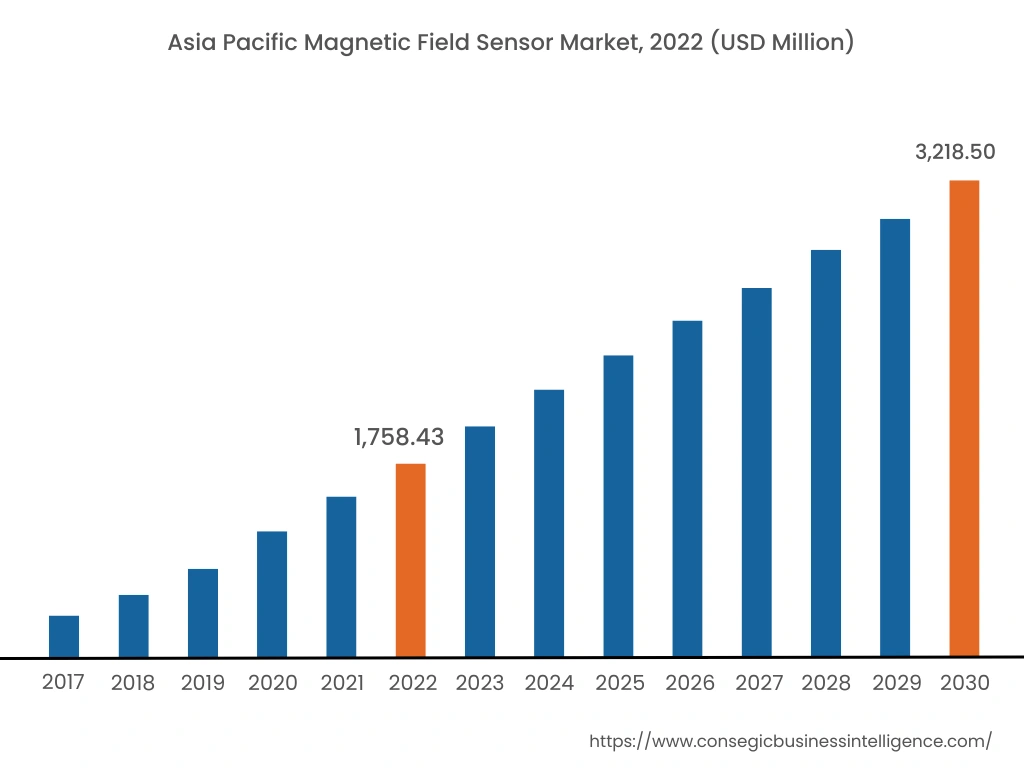
Asia-Pacific region accounted for the largest revenue share of USD 1,758.32 million in 2022 and is expected to reach USD 3,218.50 million in 2030, registering a CAGR of 8.1% during the forecast period. Additionally, in the region, China accounted for the largest revenue share of 27.38% in the year 2022. Analysis of magnetic field sensor market trends concludes that the increasing production of automobiles in the region is driving the proliferation of the market. The sensor is crucial in ADAS systems for speed and position sensing to ensure safety on roads. For instance, in March 2023, Suncall Corporation, Ltd. collaborated with Crocus Technology for the production of magnetic sensor for Suncalls' automotive products. Moreover, the growing adoption of consumer electronics such as smartphones, laptops, and tablets is driving the demand for the sensor to enable advanced features and functionalities.
North America is anticipated to witness the fastest CAGR during the forecast period. The magnetic field sensor market analysis concluded that increasing adoption of the sensor in healthcare industry is driving the expansion of the market. Magnetic field sensor plays a crucial role in radiological testing applications such as MRI machines, crucial for diagnosis and treatment planning. Moreover, technological advancements in the region in areas such as miniaturization, integration, and improved performance have contributed to the proliferation of the magnetic field sensor market in North America.
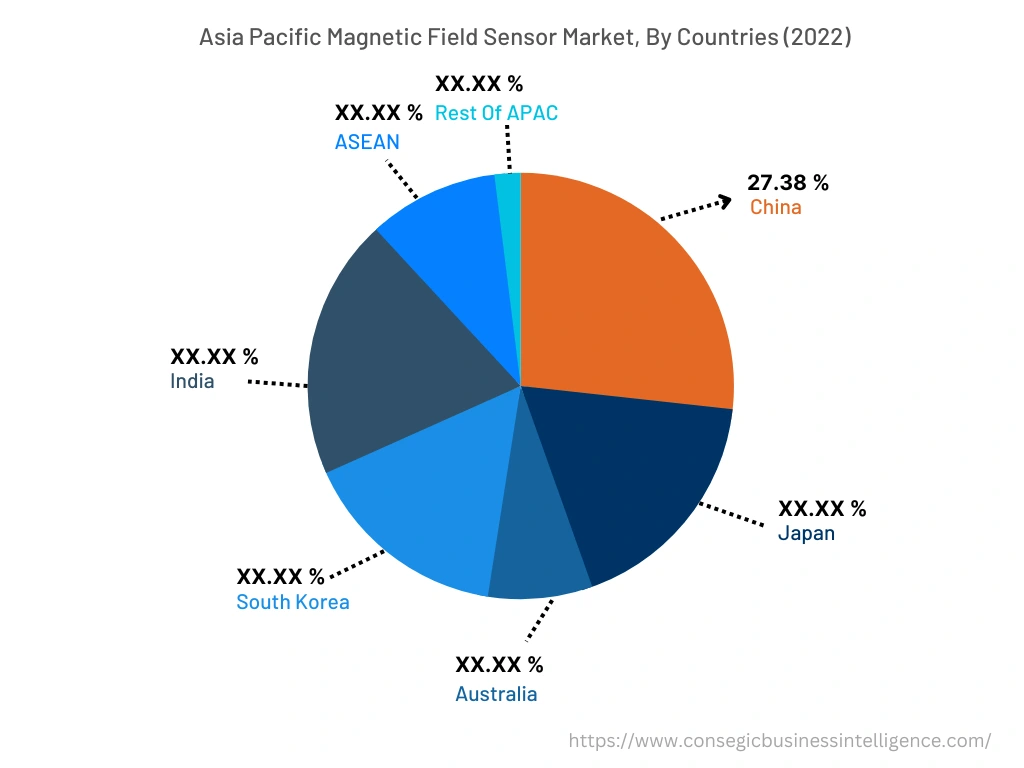
Top Key Players & Market Share Insights:
The magnetic field sensor market is characterized by the presence of key players providing magnetic sensor for position sensing, motion control and proximity sensing applications. The major companies operating in the magnetic field sensor industry are adopting several business strategies including product innovation, research and development (R&D), and application launches that accelerate the growth of the magnetic field sensor market. Key players in the market include-
- Allegro Microsystems, Inc.
- Alps Electric Co., Ltd.
- Memsic Corporation
- NVE Corporation
- NXP Semiconductors
- TDK Corporation
- Texas Instruments Incorporated
- MultiDimension Technology Co. Ltd.
- AMS AG
- Asahi Kasei Microdevices Corporation
- Baumer Ltd.
- Crocus Technology
- Elmos Semiconductor AG
- Honeywell International, Inc.
- Infineon Technologies AG
- Magnetic Sensors Corporation
- Melexis Corporation
Recent Industry Developments :
- In June 2020, NVE Corporation launched high field TMR magnetic sensor providing precise sensing in applications such as brushless DC motors, motor commutator sensor, and noncontact high-current measurement.
- In May 2021, Melexis launched single and dual-die magnetic rotary and triaxial position sensor featuring a PCB-less design for position sensing in automotive and industrial applications.
Key Questions Answered in the Report
What is Magnetic Field Sensor? +
Magnetic Field Sensor is a sensing device that detects the magnetic field around an object for speed sensing, proximity detection, and position sensing applications.
What specific segmentation details are covered in the magnetic field sensor report, and how is the dominating segment impacting the market growth? +
By type segment has witnessed hall-effect sensor as the dominating segment due to the simplicity, low-cost, and ability of hall-effect sensor to provide high measurement accuracy.
What specific segmentation details are covered in the magnetic field sensor market report, and how is the fastest segment anticipated to impact the market growth? +
By end-user segment has witnessed consumer electronics as the fastest-growing segment during the forecast period due to the growing adoption of magnetic field sensor in motion sensing, gesture recognition, and augmented reality (AR) applications.
Which region/country is anticipated to witness the highest CAGR during the forecast period, 2023-2030? +
North America is expected to register fastest CAGR growth during the forecast period due to the increasing adoption of magnetic field sensor in healthcare applications such as MRI.
